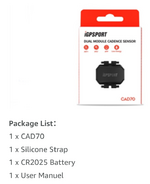fooferdoggie
Well-Known Member
math is not fun while riding if it ever is. thats why they made bike computers.If you have an analog watch with a second hand, calculating your cadence is easy. Just count revolutions for 15 seconds and multiply by four. For me it is easiest while ridding to just double the number twice. So, if it is 15 revolutions in 15 seconds, you get 30, then 60. You have a cadence of 60. It is is 20, then you get 40, then your cadence is 80.
